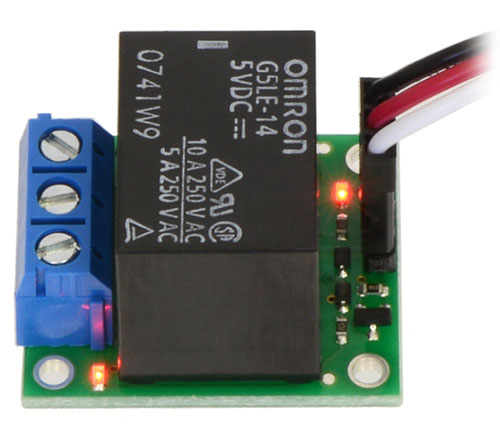PicoServo
As low as $69.99
42 In stock
- Real-Time Servo Controller
- Four Servo Outputs
- Two Trigger Inputs
- Servo Position and Acceleration Limits

Intelligent Servo Control
Each servo can have position limits set to ensure they never try to push past any mechanical obstructions. Once these limits are set, the PicoServo will scale the usable range of the servo across the entire range of the position wheel. This gives you finer control over the servo's position and makes programming much more intuitive.
Each servo can also have a maximum acceleration limit. Once set, the servo will never accelerate or decelerate faster than your specified limit. This extends the life of servos under load, and also dramatically smooths out their movements. Servos with this option enabled appear much more natural and fluid than those without it.

Servo Output Modes
The PicoServo has three different output modes. Each servo output can be set to one of the following:
- Sleep Enabled - Servos are allowed to sleep if they've sat idle for a few seconds. This can further extend the life of your servos. This feature works by halting the position signal sent to the servos. It works with most Analog servos, Digital servos will be hit and miss.
- Sleep Disabled - Use this option for servos that are required to maintain an idle position under load.
- On/Off Mode - In this mode the servo output can be used to control an amplified 5 volt relay. This allows you to control standard On/Off devices in sync with your servos. Note that a normal 5 volt relay will NOT work. You must use a relay designed for low current outputs, such as a Pololu 2481 or Keyes KY-019.

Two Trigger Inputs
Record up to 2 minutes and 43 seconds of servo animation per input. Connect the inputs to any standard sensor, button, or switch, and the PicoServo will play your animation back on command.
The second input can be used to play a different scene, or to just move the servos into a different position. For example, the first input could move the servos into one position, where they would stay until the other input was triggered.
Of course simply looping animation for an ambient prop is still possible. If desired, the second input could be used to interrupt or pause the ambient animation. Our selection of triggers can be seen here.

Escape Room Friendly
The PicoServo is Escape Room ready. It can be setup so it only runs once per game, maybe to open a secret compartment or move a small object or gauge when a certain puzzle is solved. The second input can be used as a reset, returning things to their orginal position and allowing the unit to be triggered again.
If you don't need or want to worry about resetting it, you can bypass the reset input and the PicoServo will operate in a single-shot mode. In this mode it only runs the animation once per trigger. For example, you might want some animation to run when a sensor detects an object is moved, but only once. The single-shot mode prevents looping and automatically re-arms the trigger once the object is replaced.

Input Modes
The PicoServo has five different input modes. The modes allow you to set inputs as interruptible, to only run once, or so they work with normally-closed triggers. Some modes are good for haunt applications, some for escape rooms, and some for generic applications.
A brief description of each input mode is shown below.
- Default - Both inputs are normally-open and not interruptible.
- Input 2 Interruptible - Input 2 is interruptible by input 1.
- Inputs 1 & 2 Interruptible - Both inputs are interruptible by the other.
- Run Once with Reset - Both inputs are single-shot and can only run once until the other input is pulsed to reset. Input 2 can be jumpered so the manual reset is not necessary.
- Run Once with Reset Normally-Closed - Same as above except for use with normally-closed sensors.
Over-Voltage Protection
Gone are the days where plugging in the wrong power supply for a few seconds would toast all your servos. The PicoServo checks the voltage of the connected power supply at startup. If the voltage is too high it halts and won't pass it thru to your servos, potentially saving you hundreds of dollars in replacements.

Write-Protection
The PicoServo has a write protection mechanism that helps prevent accidental or unwanted program changes. Once you've got your servos programmed the way you want them, just enter the Advanced Menu and toggle the Write-Protect feature. You can toggle it off again in the future if you need to change anything.

Servo and Trigger Power Supply Info
The PicoServo must be powered by a 5 to 7.4 volt DC power supply. Which voltage you choose will depend on which servos you choose, but generally 5 or 6 volts will work fine. A 6 volt power supply will allow the servo to apply a little more torque than a 5 volt power supply.
How much current your power supply needs depends on a lot of factors. Servo size, servo load, and how many servos are moving at any given time have the most influence on current demand. Generally, if you are using 2 or 3 standard servos under light load a 5V 2A power supply is probably fine. Otherwise, the 6V 5A power supply would be a better choice for more demanding applications.
Most powered sensors like PIR Motion Sensors and Beam Sensors require a minimum of 9 or 12 volts. Since the PicoServo's power supply is not that high, a separate power supply will be required to use one of these sensors. Note that buttons, switches, magnetic proximity sensors, and pressure mats are all non-powered. These can be used without any additional power supply.

